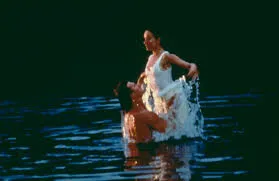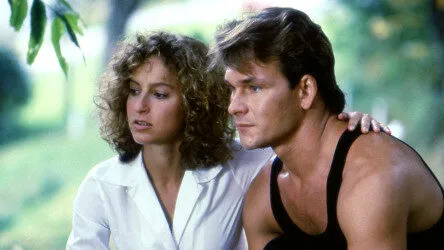Dirty Dancing (1987) – A Timeless Tale of Love, Passion, and Dance
Few films capture the magic of youthful romance and self-discovery quite like Dirty Dancing. Released in 1987, this classic drama, directed by Emile Ardolino, remains a cultural phenomenon that transcends generations. With its intoxicating blend of electrifying dance sequences, unforgettable music, and raw emotional depth, Dirty Dancing is more than just a film—it’s an experience, a cinematic love letter to freedom, passion, and finding oneself.

A Story That Dances Its Way into the Heart
Set in the summer of 1963, the film follows Frances “Baby” Houseman (Jennifer Grey), a bright but sheltered young woman who embarks on a family vacation to the upscale Kellerman’s resort in the Catskills. What begins as a mundane getaway soon turns into a life-changing journey when she stumbles into the world of forbidden dance and undeniable attraction.
At the center of this world is Johnny Castle (Patrick Swayze), the resort’s charismatic yet troubled dance instructor. With his magnetic presence and rebellious spirit, Johnny embodies everything Baby has never known—passion, independence, and the unspoken language of movement. When circumstances force Baby to become his dance partner, an unexpected love story unfolds, one that defies class barriers, social expectations, and even her own self-doubt.

Chemistry That Burns the Screen
What makes Dirty Dancing truly legendary is the blazing chemistry between Jennifer Grey and Patrick Swayze. Their on-screen relationship feels raw, organic, and deeply authentic, making every stolen glance and lingering touch pulse with intensity. The transformation of Baby from a naïve girl to a confident, empowered woman is beautifully portrayed, while Johnny’s journey from an outsider struggling for respect to a man who learns to believe in love is equally compelling.

Dance as a Metaphor for Liberation
The film’s choreography, crafted by Kenny Ortega, is pure magic. Every routine tells a story—of longing, rebellion, desire, and self-discovery. From the sensual “Love Is Strange” rehearsal scene to the breathtaking, climactic performance of “(I’ve Had) The Time of My Life,” dance serves as the ultimate symbol of freedom and transformation.
Johnny and Baby’s final performance is cinema at its finest—a triumphant moment where love, confidence, and defiance collide, leaving audiences breathless. And of course, the iconic lift—a move so legendary that it still inspires dance enthusiasts and hopeless romantics today.

A Soundtrack That Defined a Generation
Music is the film’s heartbeat, elevating every scene with anthems that remain just as powerful decades later. Songs like “Hungry Eyes,” “She’s Like the Wind,” and “Be My Baby” set the tone for romance and longing, while “(I’ve Had) The Time of My Life” cements its place in cinematic history. The soundtrack topped charts worldwide, proving that Dirty Dancing was more than just a film—it was a cultural movement.
Themes That Resonate Across Time
Beneath its glittering dance sequences and steamy romance, Dirty Dancing explores timeless themes of self-discovery, class struggle, and breaking societal expectations. Baby, raised in privilege, learns to see the world through new eyes, challenging her family’s ideals and fighting for what she believes in. Meanwhile, Johnny represents the working class fighting for respect, proving that talent and integrity are not bound by social status.

Why Dirty Dancing Remains Unforgettable
Even decades after its release, Dirty Dancing continues to captivate audiences with its unapologetic romance, electrifying performances, and empowering message. It’s a film about first love, about standing up for oneself, and about the moments that define who we are.
It’s no surprise that fans return to it time and time again. Because Dirty Dancing isn’t just a movie—it’s a feeling, a memory, a celebration of love and the power of dance.
⭐ Rating: 10/10 – A Perfect Blend of Romance, Dance, and Heartfelt Storytelling